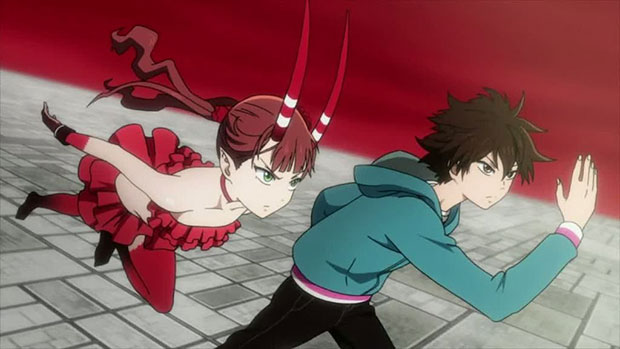Anime Review: C-Control
By Andrew Erickson

Gold rules the world. At least, that’s the premise of Tatsunoko Production’s 2011 show, [C] – The Money of Soul and Possibility Control (from here on referred to just as C). Directed by Kenji Nakamura, the series follows university student Kimimaro Yoga, who spends most of his time studying and working two convenience store jobs in the hope of one day having a good, stable career. One day, a man named Masakaki knocks on Yoga’s door offering to multiply his income several times over if he’ll pay a visit to the Financial District. Against his better judgment, Yoga ends up getting roped into Masakaki’s scheme, involves throwing prospective investors into duels. Each participant is given an assistant, called an Asset, whose attacks become more powerful as their owner places more money at stake. Essentially, stock trading visualized as combat. The catch is that investors offer up their future as collateral, and if they go bankrupt, that’s it: they forfeit their Asset, their right to enter the district, and anything gained through their prior earnings.
C has all the elements of a straightforward shonen series – the young male protagonist, unsatisfied with his boring life, is thrust into a new world and given unbelievable power, ends up fighting a series of increasingly powerful opponents, etc. – but the action isn’t actually the focus. It follows rules (vaguely), Yoga acquires new powers (once), and one of the most important fights takes place almost completely off-screen. In the following episode, Yoga meets his enemy after the fact and the two discuss how incredible their confrontation was, in one of the most transparent “you ran out of ink, too, didn’t you” moments I’ve ever seen. Anyone who comes into C hoping for exciting set pieces is going to be disappointed. They’re best written off as inconsequential, because the studio staff clearly treated them that way.
What’s more important is the personal struggle Yoga faces. Initially out for nothing more than a quick buck, he starts to change his mind when confronted by the antagonist, Souichirou Mikuni, who seeks to limit any individual from gaining too much influence in the district, lest it destabilize the economy. The decision Yoga has to make is twofold: whether a frequently unpleasant but stable status quo is worth sacrificing a potential life of comfort, and how much he can stand to enlarge his savings at someone else’s expense. Even when he has the ability to walk all over a challenger, Yoga often feels he has to restrain himself for fear of ruining someone’s life. Ironically, the money that he thought would set him free becomes an unwanted complication in what would otherwise be straightforward fights. So it’s only fitting that there’s a strong theme of money as a tool for controlling people: Masakaki attempts to bribe Yoga into joining the Financial District by depositing money into his bank account, Mikuni believes he can manage Japan’s future by controlling the printing of money, and, more literally, the Assets and their money-fueled attacks represent economic concepts, like Ko Sennoza’s “angel investor” that fights on his behalf. In the world of C, money literally is power.
If it’s an obvious, unoriginal theme, then it at least earns points for presentation thanks to Hiroshi Ito’s art direction. The Financial District feels like an alien world, operating under a gigantic yen coin instead of the sun, flat surfaces are covered in rectangles that give the impression they’re made out of painted-over bills, the streets are paved with gold, the “Midas money” that circulates in the district resembles tarot cards more than currency, and Masakaki parades through it all in bright pink and blue formal wear. It’s an enormous casino where the ones who stand out the most are those who try to dress respectably. The one stumbling block in the show’s visuals is Yoga’s Asset Msyu, who looks like the character designers were instructed to make a marketable female mascot character. Of course Yoga had to get the one Asset that isn’t visibly monstrous in some way, but they could have at least put clothes on her.
Where writer Noboru Takagi most prominently fails is crafting memorable characters. Everyone, from Yoga to Mikuni, is so beaten down by fiscal troubles that it becomes a little one-note after a while. The kind professor with an idyllic family life is actually wracked by suicidal depression. The cheerful philantrophist who helps people for the love of it is secretly terrified of becoming insolvent. Yoga’s friend from college degenerates into a hopeless shut-in. And so on. Yoga is already supposed to be the relatable everyman, so more variation in the supporting cast would have emphasized his status as a fish out of water in the Financial District. The sole exception to this pattern is Masakaki, who is one-note in a different way – he’s a cackling imp from his first appearance to his last, with no development in between, but he at least adds some color to things. And while it might be thematically appropriate for the only character absolutely free from money problems to also be the only one happy with his life, it’s harder to care about the central conflict when all the major players are so dour. Maybe this tone can be attributed to being written in the aftermath of the Great Recession, but at any rate some more levity would have been appreciated. In this respect, Funimation’s dub works wonders making the characters relatable, especially Todd Haberkorn’s performance as Yoga.
At 11 episodes, the series’ storyline feels truncated, with most of the major developments occurring in the last few episodes, but the premise and buildup to that point are interesting. On the whole, I enjoyed C and feel it’s worth watching, especially for those interested in economics. There are some neat concepts at play under its “fight of the week” veneer.
The Wrapup
Pros:
- unique premise
- very good visual design
- engages with some interesting themes
Cons:
- somewhat monotonous characterization
- rushed story arc
- poorly realized shonen elements



Follow Us!